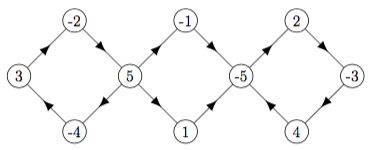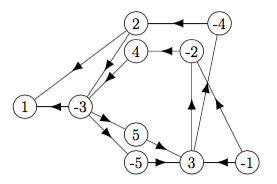coping with NP-C
exhaustive tree search (ETS)
common form of exhaustive search: traverse a decision tree
tree search: traversal of search space based on a decision tree
e.g. sat: choice 0/1 for each boolean variable
left branch of node at depth k: variable k = 0
left branch of node at depth k: variable k = 1
usually, depth first traversal
in memory, only need path from root to current node
example below for n = 4, variables x0 x1 x2 x3

intelligent ETS: backtracking
with no improvements, WC, whole tree traversed
how to avoid searching whole tree?
backtrack when current node cannot extend to solution
example below for n = 4, variables x0 x1 x2 x3
initialize formula f, say [0 1 2 3] [0 -1] [1 -2] [2 -3]
loop
if f has 0 clauses, return SAT
if some clause has 0 literals, return UNSAT
pick next variable not yet set, say x
for L in { x, -x } : # set x = True, x = False
if L in c, remove c from f
if -L in c, remove x from c
sat solvers

use current partial solution to pick next search step
use current reduced formula to pick next variable to set
e.g. if some clause has size 1, set variable so clause sat
more generally: set variable from any shortest clause
improving sat solvers is continuing research area
classic sat solver DPLL
unit propagation
pure literal elimination
best sat solvers still wc exptime
below: simple sat solver
set variable from any shortest clause
backtrack once some clause unsat
def sat(f): return (True if len(f)==0 else False)
def unsat(a): return (True if a[0]==UNSAT else False)
def backsat(f,a):
if unsat(a) or sat(f): return f,a
minj = f.index(min(f,key=len)) # clause with fewest literals
if len(f[minj])==0:
a[0] = UNSAT
return f,a
if len(f[minj])==1:
fixliteral(f[minj][0], f, a)
return backsat(f,a)
#split: 2 possible bool. vals for literal f[minj][0]
fcopy, acopy = mycopy(f,a)
fixliteral(f[minj][0], f, a) # f[minj][0] True
f,a = backsat(f,a)
if sat(f): return f, a
f,a = fcopy, acopy
fixliteral(-f[minj][0], f, a) # f[minj][0] False
return backsat(f, a)
above solves random n, k, m = 30, 5, 600 instance in few seconds, while brute force takes much longer (why?)
e.g. knapsack, each value/wt has O(logk n) bits, polytime
e.g. 2-sat?
f1 = [[1,-5],[-2,-3],[3,4],[-4,-5],[2,5],[-1,-5]] satisfiable ?
f2 = [[1,-2],[1,3],[-2,-3],[2,4],[-3,-4],[3,-5],[3,5]] satisfiable ?
polytime 2-sat via implication digraph
one node for each literal
for each clause [a,b]
draw arc from literal negate(a) to literal b
draw arc from literal negate(b) to literal a
e.g. formula f1 below
nodes (1) (2) (3) (4) (5) (-1) (-2) (-3) (-4) (-5)
clause [1 -5] (-1) ----> (-5) (1) <---- (5)
clause [-2 -3] (2) ----> (-3) (-2) <---- (3)
...


n variables, m clauses
construct implication digraph D
if some scc of D contains literal x and -x then unsat (why ?)
otherwise
consider sink scc S of D
assign literals according to S (no inconsistencies: why ?)
remove S, and all variables in S, from D
continue with remaining digraph D'
this algorithm takes polytime (why ?)
this algorithm correct (why ?)
f1 has sccs {-2 5 -4 3} {-1} {1} {2 -3 4 -5}
no scc contains both x and -x, so f1 satisfiable
sink scc {2 -3 4 -5} so set 2T 3F 4T 5F
from digraph, remove this scc and all instances of variables 2 3 4 5
remaining digraph has sccs {-1} {1}
each is sink scc, so pick either, assign 1F or 1T
f1 has sccs {-1} {-2 2 -3 3 -4 4 -5 5} {1}
some scc contain both x and -x, so f2 unsatisfiable
3-sat phase transition
if clause/variable ratio m/n small, say ≤ 3
Prob(sat) close to 1
easy to solve
if clause/variable ratio m/n big, say ≥ 5
Prob(sat) close to 0
easy to solve
if clause/variable ratio m/n ≈ 4.2
Prob(sat) close to .5
hardest to solve
easy-hard-easy common to NP-C